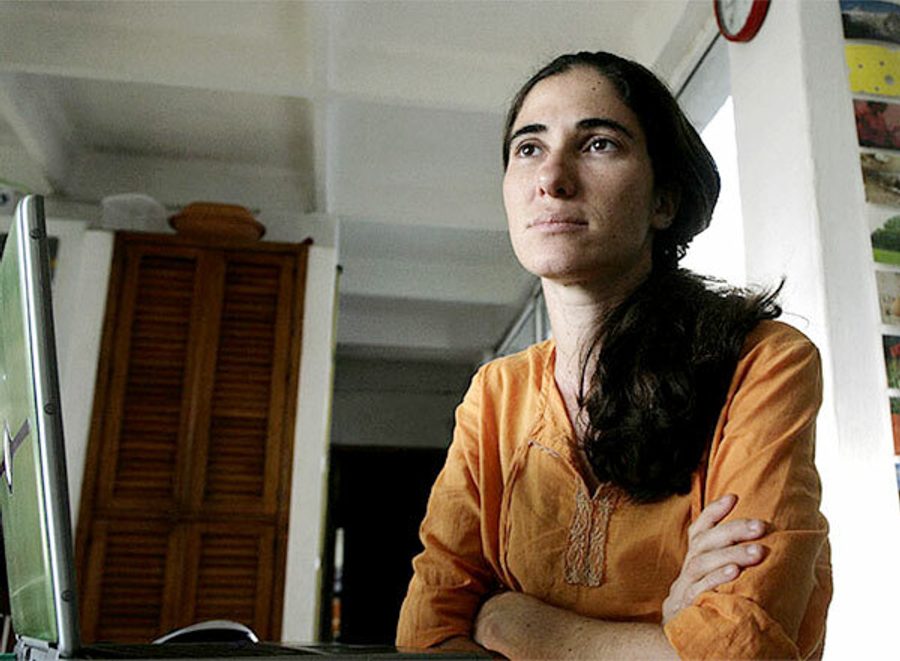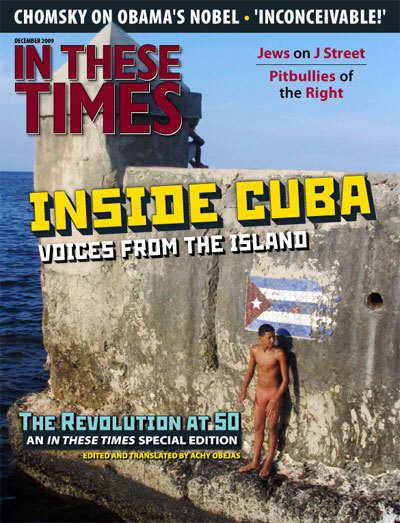
“Blog.” Many people in Cuba don’t understand all the fuss regarding this mono-syllabic word that seems to have no relationship to the daily routine of survival.
On the Island, the blogosphere is an incipient media and, outside of Havana, all but invisible. Though their work generates controversies and awards worldwide, Cuban bloggers are largely unknown here. With Internet access in Cuba restricted to the very few, the nation’s bloggers function as a kind of guerrilla underground. They work as independent agents whose existence heralds a civic re-activation that will modulate the Revolution’s Realpolitik–or is that Raúlpolitik?
Blogs Sobre Cuba, an online database founded in 2007, lists more than 1,000 blogs on Cuban topics, both on and off the island.
The State monopoly of the printed word, which continues to be the media most read, doesn’t seem interested in acknowledging the 21st century’s cursed tetragrammatron: BLOG. So when a State journalist needs to quote from some foreign (never domestic) blog in his article, he does it with sterilized surgical gloves, never explaining the format of his source.
Curiously, these same State newspapers have their own digital replicas that are a lot less orthodox than their print counterparts. They’re on State cyber-portals that celebrate the government’s achievements in health, sports, technology, education, tourism, culture, etc. As a counter-offensive in the “War of Ideas,” dozens of official journalists are also allowed to hang blogs on sites such as Bloggers Cuba and Blogueros y Corresponsales de la Revolucion . In both cases, the vast majority of these writers are male and white – not exactly reflecting the country’s population or the rest of the world’s multi-culti blogosphere. Even Fidel Castro has become a blogger with the publication of his reflections in Cubadebate.
Anidelys Rodriguez, a communications professor at the University of Havana, has studied the blogs in the State-sponsored Cuban blogosphere. According to Rodriguez, the majority reflect “professional ideologies and traditional news values” and “a self-imposed commitment to re-affirm national identity.” In other words, these are not personal blogs but appendices to the State media in which the writers already work.
Perilous connections
But for a Cuban blogger to get to the mythical Ithaca that is the Internet, they must first navigate an odyssey of obstacles. First, there is the scandalous cost of connecting, which in just a couple of hours can swallow an average monthly salary ($15 to $20 U.S.). Then there are the Paleolithic browsing speeds (usually less than 50 Kbps). And finally, of course, there is the ministry-level apartheid that prohibits Cuban nationals from opening a web account with ETECSA, the national telephone company – whereas any foreign resident can do so with a simple bureaucratic application accompanied by hard currency.
Nonetheless, whether through tricks or under-the-table payments, information in Cuba today travels with unprecedented speed. Some people use online computers at diplomatic compounds, like the U.S. Special Interest Section, and thus are attacked as “dissidents” by official spokespersons. Many occasionally log on from hotels to upload and download all their material for the week – or the month. (Sometimes Cuban nationals are allowed to do this openly, other times they’re banned from the cyber cafes at hotels that cater to foreigners; it’s always a mystery what will happen at any given hotel on any given day.) Others don’t upload or download their texts and images themselves, but send them instead, as e-mail attachments, to a collaborator who will do them the favor from abroad. This is also how many blogs publish in different languages.
According to the National Office of Statistics (which doesn’t count anything outside of formal channels), out of a Cuban population of more than 11 million, only 1.5 million use the Internet. Online connections made through student or work centers ban “pornographic and counter-revolutionary” sites, creating an incriminating nexus between those two words, and denying access to almost everything published by Cubans abroad. Domestic connections authorized for individual government officials are, in practice, also domesticated: portals such as Cubanet and Cuba Encuentro, both exile news services, are blocked by the Cuban government, as are various proxy servers. Cuban national servers, such as Infomed and Cubarte only allow browsing on “.cu” domains, which are exclusively Cuban State pages and as such are a kind of cyber chastity belt euphemistically referred to as the “Intranet.” In practice what this means is that most of the few Cubans who have online access don’t, in fact, have access to the Worldwide Web at all – only to e-mail.
Users on these restricted networks assume that their e-mails are monitored, or even erased if they contain politically incorrect words. To violate State sensibility can mean having the service suspended, or worse.
Take the case of Ángel Santiesteban, who writes a blog called Los hijos que nadie quiso (The Children Nobody Wanted).
Santiesteban, a much-lauded writer who has won most of Cuba’s top literary prizes, wrote about the shameful behavior at a minor Mexican book fair of a delegation of Cuban writers In essence, he chided these writers “who never question government management” for opportunism, and for demanding abroad what they would never ask for at home. He quoted one anonymous writer as saying he/she had agreed to go to Mexico because of the “proper meals, daily clean sheets, CNN and hot water for showers.”
Following that blog post, Santiesteban was called in by an official with the Instituto del Libro. The tiff with the functionary inspired more blogs and an assault on the street that left Santiesteban with a broken arm, but still able to write. Since his blog isn’t available in Cuba, it was presumed that his assailants, who called him “counterrevolutionary,” were sent by State security. Santiesteban filed complaints with both the Union of Writers and Artists of Cuba and the Ministry of Culture, which have promised to investigate.
Then there is the story of Erasmo Calzadilla, a former university professor who writes for Havana Times, an English-language portal that was originally run from Cuba by a State-employed, foreign-born interpreter. (The site is now operated from Nicaragua, where the owner lives after losing employment in Cuba.) Calzadilla, 34, was fired from his university, Instec, after posting a series of entries on controversial topics, such as the naïveté of foreigners when it comes to Cuba, or how gay Cuban couples have nowhere to go to have sex. He detailed his dismissal from the faculty in his blog as well and, now teaching at another school, continues to write for Havana Times.
In spite of this panoptic attempt to control a medium as emancipating as the web, Cuba has one of the most popular blogs in the world: Yoani Sánchez’s Generacion Y. Sánchez is a 34-year-old philologist who doesn’t write for a newspaper or have access to too many interactive tools, but she’s at the cutting edge of Cuba’s digital revolution. (The name of her blog stems from the curious predilection of Cubans in the ’70s and ’80s to name their children with Russian sounding names.) Like a lot of sites from the Island, including many official ones, Sánchez uses a foreign-based server to guarantee the integrity and security of her material.
In a gesture of solidarity that serves as an example of the Cuba’s independent blogosphere, she shares her site, Voces Cubanas , for free and without hierarchies, conditions or political sectarianism, with any Cuban national who wants to create a blog.
On a government site, Cambios en Cuba, which seems practically dedicated to slamming Sánchez, authorities have added to the Generaci – n Y logo a swastika and letters reading “CIA.”
Because of the stigma now attached to Generacion Y many people interested in blogging are cautious about actually doing so just yet. But the diversity on Voces Cubanas is already well-known, including popular blogs like Sin Evasion and Desde Aqui ; the very dramaticVoz Tras las Rejas, written by the journalist Pablo Pacheco, who’s actually in prison at an undisclosed location and whose work is produced completely in defiance of the authorities; the irreverent Octavo Cerco; a replica of Sánchez’s blog, given that the original continues to be blocked in Cuba by the authorities vocescubanas.com/generaciony and my own photo-blog, Boring Home Utopics.
Due to the high cost of connection in Cuba, those who can connect rarely read online, so the distribution of blog materials on the island itself happens through other means, particularly memory sticks and CDs. Unquestionably, immediacy and feedback are affected by these second- and third-hand reading experiences, which sometimes disconnect the bloggers from their natural audience.
In addition, Sánchez has organized Itinerario Blogger 2009, which facilitates theoretical and technical exchanges about the blogosphere and its repercussions worldwide. This past summer, Kelly van der Kwast , a frequent contributor to the Huffington Post, participated in an underground workshop in the provinces for future bloggers.
Though the Cuban blogosphere is still emerging and can only be read in its entirety from outside (of course, on the Island, State security apparatchiks follow every little millimeter of progress, every update), today there’s a certain optimism among local participants.
The State has not yet passed specific laws against a phenomenon as new as blogging, although the habit of accusing critical voices of being “capitalism’s useful idiots” or “mercenaries of enemy propaganda” can serve as a brake on free expression. “It’s secret work and neo-colonial journalism,” Fidel Castro said of Sánchez in 2008. But the attacks on and persecution of bloggers like Santiesteban and Calzadilla are, of course, frightening. There are also legal warnings issued for “peligrosidad predelictiva,” or “dangerous inclination to criminality” that has been used to arrest and harass, but not yet convict.
Some well-known Cuban opposition figures have just recently begun to experiment with this form of instant publication, and they consider the bloggers possible allies in their efforts toward a democratic transition. But there’s a generational conflict because the bloggers’ infamy has practically taken traditional dissidents out of the media spotlight.
For now, the Cuban blogosphere perseveres, on and off the island, with a broad, chaotic diversity of opinion on all sides – a virtual democracy, against all odds.
Orlando Luis Pardo Lazo is editor of the e-zine The Revolution Evening Post. He is the author of Collage Karaoke (Letras Cubanas, 2001), Empezar de cero (Extramuros, 2001), Ipatr’as (Unicornio, 2005), Mi nombre es William Saroyan (Abril 2006) and Boring Home (digitally domestic, 2009). E-mail orlandoluispardolazo@gmail.com.







